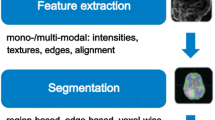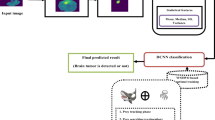Abstract
Precise tumor segmentation plays a significant role in radio surgery arrangement and the evaluation of radiotherapy treatment efficiently. To increase the performance and lessen the unpredictability included in the medical image segmentation, transform-based 2D U-ConvNet cerebrum tumor segmentation has been explored. Additionally, to improve the exactness of the support vector machine (SVM) classification, appropriate attributes are extricated from every segmented tissue. The simulation outcomes of this method have been assessed and confirmed for the performance and quality validation of MRI images based on various performance evaluation parameters. This method accomplished the segmentation accuracy of 93.8%, the sensitivity of 87.6%, the specificity of 94.8%, and the recall of 85.6%, exhibiting the efficacy of the proposed method for recognizing ordinary and tumor tissues from MRI images.








Similar content being viewed by others
References
Liua B et al (2015) Noise suppression in brain magnetic resonance imaging based on non-local means filter and fuzzy cluster. Optik 126(21):2955–2959
Dolui S et al (2013) A new similarity measure for non-local means filtering of MRI images. J Vis Commun Image Represent 24(7):1040–1054
Kleesiek J et al (2016) Deep MRI brain extraction: a 3D convolutional neural network for skull stripping. Neuroimage 129:460–469
Isin A, Direkonglu C, Sah M (2016) Review of MRI-based brain tumor image segmentation using deep learning methods. Procedia Computer Science 102:317–324
Havaei M et al (2017) Brain tumor segmentation with deep neural network. Med Image Anal 35:18–31
Kamnitsas K et al (2017) Efficient multi-scale 3D CNN with fully connected CRF for accurate brain lesion segmentation. Med Image Anal 36:61–78
Ayachi R, Ben Amor N (2009) Brain tumor segmentation using support vector machines. In: Sossai C., Chemello G. (eds) Symbolic and Quantitative Approaches to Reasoning with Uncertainty. ECSQARU 2009. Lecture Notes in Computer Science, Springer, Berlin, Heidelberg, vol 5590, pp. 736–747, 2009
Bauer S, Nolte LP, Reyes M (2011) Fully automatic segmentation of brain tumor images using support vector machine classification in combination with hierarchical conditional random field regularization. In: Fichtinger G., Martel A., Peters T. (eds) Medical Image Computing and Computer-Assisted Intervention – MICCAI 2011. MICCAI 2011. Lecture Notes in Computer Science, Springer, Berlin, Heidelberg. vol 6893, pp 354–361
Lefkovits L, Lefkovits S, Szilágyi L (2016) Brain tumor segmentation with optimized random forest. In: Crimi A., Menze B., Maier O., Reyes M., Winzeck S., Handels H. (eds) Brainlesion: Glioma, Multiple Sclerosis, Stroke and Traumatic Brain Injuries. BrainLes 2016. Lecture Notes in Computer Science, Springer,Cham, vol 10154, pp. 88–99
Rios Piedra EA et al., (2016) Brain tumor segmentation by variability characterization of tumor boundaries. In: Crimi A., Menze B., Maier O., Reyes M., Winzeck S., Handels H. (eds) Brainlesion: Glioma, Multiple Sclerosis, Stroke and Traumatic Brain Injuries. BrainLes 2016. Lecture Notes in Computer Science, Springer, Cham, vol 10154,pp. 206–216
Song B, Chou CR, Chen X, Huang A, Liu MC (2016) Anatomy-guided brain tumor segmentation and classification. In: Crimi A., Menze B., Maier O., Reyes M., Winzeck S., Handels H. (eds) Brainlesion: Glioma, Multiple Sclerosis, Stroke and Traumatic Brain Injuries. BrainLes 2016. Lecture Notes in Computer Science, Springer, Cham, vol 10154, pp. 162–170
Li Y, Jia F, Qin J (2016) Brain tumor segmentation from multimodal magnetic resonance images via sparse representation. Artif Intell Med 73:1–13
Long J, Shelhamer E, Darrell T (2015) Fully convolutional networks for semantic segmentation, 2015 IEEE Conference on Computer Vision and Pattern Recognition (CVPR), Boston, MA, 2015, pp. 3431–3440
Andreas Maier et al., (2019) A gentle introduction to deep learning in medical image processing, Zeitschrift für Medizinische Physik, Vol 29, Issue 2, May pp. 86–10.
Ronneberger O, Fischer P, Brox T (2015) U-net: convolutional networks for biomedical image segmentation, CoRR, vol. abs/1505.04597, 2015
Xu Y et al., (2016) Gland instance segmentation by deep multichannel side supervision. In: Ourselin S., Joskowicz L., Sabuncu M., Unal G., Wells W. (eds) Medical Image Computing and Computer-Assisted Intervention – MICCAI 2016. MICCAI 2016. Lecture Notes in Computer Science,Springer,Cham, vol 9901, pp. 496–504
Nie D, Wang L, Gao Y, Shen D (2016) Fully convolutional networks for multi-modality isointense infant brain image segmentation, 2016 IEEE 13th International Symposium on Biomedical Imaging (ISBI), Prague, pp. 1342-1345
Bahadure NB et al (2017) Image analysis for MRI based brain tumor detection and feature extraction using biologically inspired BWT and SVM. Int J Biomed Imaging 2017:1–12
Author information
Authors and Affiliations
Corresponding author
Ethics declarations
Ethics approval
No human or animals used in our research.
Consent to participate
Not applicable.
Consent for publication
We give our consent for the publication of identifiable details, which can include figures and graphs within the text to be published in the Personal and Ubiquitous Computing Journal.
Conflict of interest
The authors declare no competing interests.
Additional information
Publisher's note
Springer Nature remains neutral with regard to jurisdictional claims in published maps and institutional affiliations.
Rights and permissions
About this article
Cite this article
Pitchai, R., Supraja, P., Sulthana, A.R. et al. MRI image analysis for cerebrum tumor detection and feature extraction using 2D U-ConvNet and SVM classification. Pers Ubiquit Comput 27, 931–940 (2023). https://doi.org/10.1007/s00779-022-01676-y
Received:
Accepted:
Published:
Issue Date:
DOI: https://doi.org/10.1007/s00779-022-01676-y




